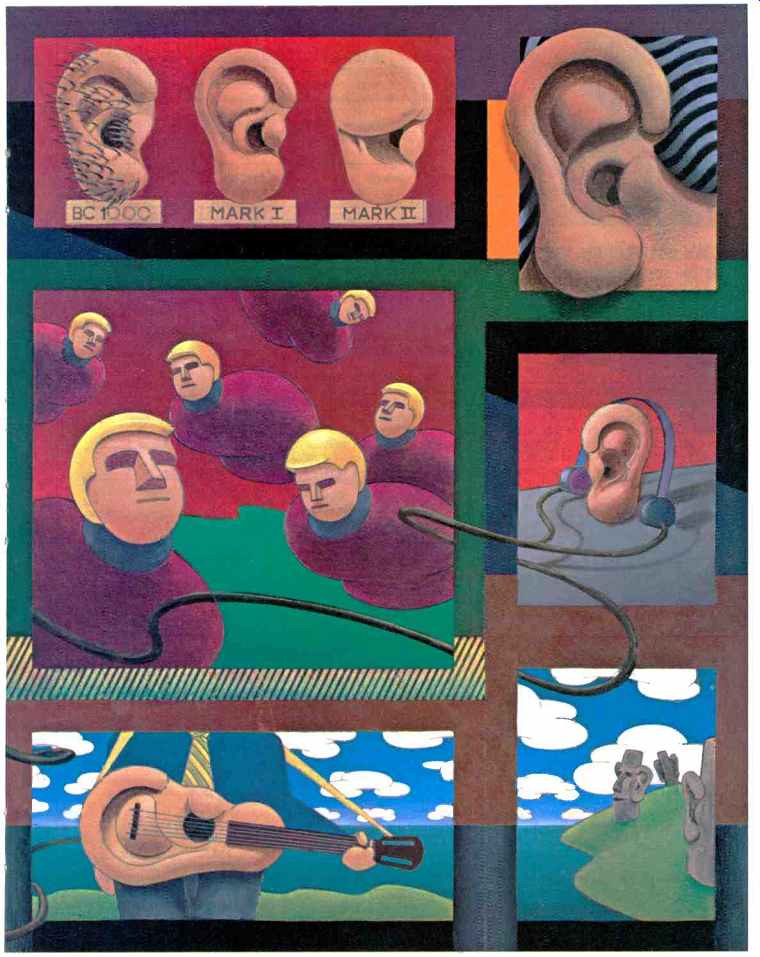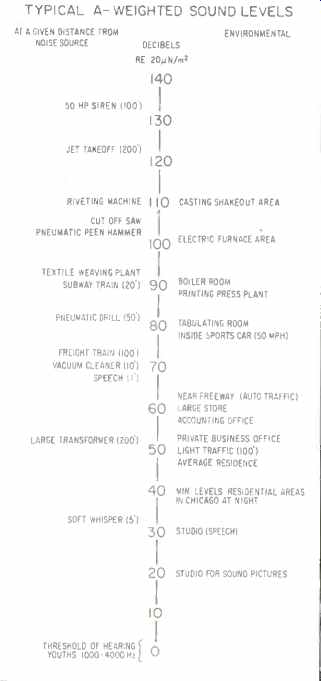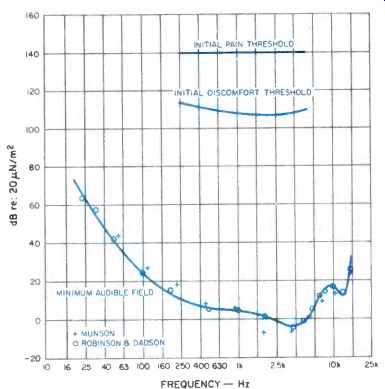Author: SIMEON COSTA
Unless ears translate a sound wave, it remains nothing more than a mass of vibrating air, no matter whether the wave is bass or treble, loud or soft, instrumental or vocal. And if that sound is distorted or lost in the mysterious chambers of your ears, there isn't much point in investing time and money to achieve "perfect" sound. All of this is good reason, even while you are engrossed in the superb performance of the latest turntables, receivers, equalizers and speakers, to pay some attention to your personal hearing components.

The two ears you started out with are the only ones you will ever have.
Should anything happen to this original equipment, your friendly stereo dealer won't be able to supply replacements. What's more, even though modern microsurgery sometimes can do such amazing things as reattach arms and legs, there is no way to repair one of the most common types of ear damage that causes hearing loss.

This limiting of ears to two per customer might not be anything to be concerned about if we didn't have an oversupply of ear troubles. More than 16-million Americans already have defective hearing. And the longer we live, the more likely we are to develop substandard hearing. According to U.S. government figures, the incidence of impaired hearing grows from about 36 per 1,000 at ages 45-54, to 64 per 1,000 at ages 55-64, to 125 per 1,000 at ages 65-74, to 262 per 1,000 at ages above 70. Of particular interest to audiophiles is that when hearing goes haywire in middle age, the capability most often affected is the ability to hear high-pitched tones. There are no statistics on the number of people 30 and older who no longer are able to hear higher frequencies properly and make the critical tone distinctions required to appreciate high-fidelity music. From every indication, however, it seems that a big slice of the U.S. population suffers from this peculiarly annoying kind of hearing loss. Stereo owners hate to admit they have a problem that no amount of equipment upgrading can correct, but one slightly gray-at-the-temples audio buff was heard to say, "By the time I could afford the very best in sound equipment; my hearing was too far gone for me to enjoy it!" That's the bad news.
The good news is that you can protect your precious ears and greatly increase the odds that your hearing will be okay even after you are collecting Social Security. Also, improvements in hearing aids are helping some people hear the sounds of stereo better.
The basic problem with the human ear is that it is a very old model. There have been no changes in the fundamental design for millions of years.
Your auricles (external earflaps) may be less hairy than those of your prehistoric ancestors, but otherwise your ears duplicate ones worn during the Stone Age.
At the time the original Mark I human ear was designed and approved for production, environmental conditions and lifestyles differed considerably from those of today. For example, there wasn't too much noise in the primeval forests. The loudest sounds were an occasional clap of thunder and the screams of animals or humans. Nobody was cutting up trees with a chain saw or racing around in a snowmobile.
Loud and continuing noise can damage hearing beyond repair by destroying some of the 30,000 "hair cells" or nerve endings in the inner ear. These actually convert sound vibrations into neuro-electrical energy for transmission to the hearing center of the brain. Once damaged, these cells are gone for good. They never grow back! The Mark I ear--the kind you are currently wearing--is equipped with some built-in, although limited, protection against thunderous noises. Any loud, sudden bang causes a reflex action in two tiny muscles located in the middle ear. The tensor tympani contracts and stiffens the eardrum so it can't vibrate as freely as it normally does. And the stapedius muscle pulls on the little stapes (stirrup-shaped) bone which more or less immobilizes the movement of the little chain of bones that transmits sound from the eardrum to the inner ear. The overall effect is to reduce the transmission of sound and shield the delicate nerves of the inner ear.
This muscle-reflex action, while a kind of Rube Goldberg engineering, probably gave adequate protection in quiet, prehistoric times. Thunderclaps are relatively infrequent and come at longish intervals, so the little ear muscles received an opportunity to rest between bangs. Today, however, things like engines and rivet guns bang, bang, bang hundreds of times a minute and for long periods. The tiny tensor tympani and stapedius muscles become tuckered out in a few moments and leave the ear wide open to a flood of destructive decibels.
Another shortcoming of the Mark I protection system is that it does little to shut out high-frequency sounds. This was of no great importance to early man who probably was careful to keep his distance from such high-pitched noises as the scream of a saber -tooth tiger. Besides, anybody who found himself inches from the mouth of a screaming carnivore probably never got to the tribal otologist to be checked for possible impairment of his hearing. Today we are not involved with saber-fanged felines, but we often get too close to the high -frequency noises created by turbo-jet engines, high-speed tools, food blenders, air circulators and other modern devices that assault the ears.
You can work or play in a noisy environment-if it isn't too bad-for a limited time and suffer only a temporary loss of hearing acuteness. But sustained noise levels of 85 dB (some authorities put the danger line at 75 dB) or more are hazardous to human hearing. Noisy city streets with blaring automobile horns can develop upwards of 80 dB, and subway stations have been metered at levels over 110 dB when trains were pulling in and out.
Finally, your obsolete Mark I ears have no built-in protection against the extreme "impact" noises of civilization-such as gunfire, firecrackers, blasting, huge gongs and church bells (when close up), super -foghorns and a whole catalog of industrial bangs and shrieks. In addition to destroying nerve cells, the implosion of literally ear-splitting sounds actually can split eardrums and dislocate or fracture the internal ear bones.
When and if genetic engineers get around to redesigning the human ear, some important changes would be highly desirable. Certainly the Mark If ear should offer far better noise protection than the current model.
One way would be to develop extended and movable auricles. These would resemble the hanging earflaps found on some breeds of dogs, but would incorporate voluntary muscles under the control of the individual.
Upon entering a noisy area, the flaps could be fully or partially closed, depending on the volume of sound encountered. This volume control would be particularly valuable at rock concerts and disco palaces, where it is desirable to admit some sound, but not the full impact of high -decibel music which has proved hazardous to hearing.

Typical modern sound levels, in dB relative to threshold of human hearing.
Sustained noise levels above 75 to 85 dB are dangerous to the ear. (From
the Handbook of Noise Measurement by Arnold P. G. Peterson and Ervin
E. Gross, Jr., published by General Radio.)
Promising as biological earflaps might be, their possible future development offers nothing to us today since we must make do with standard Mark I ears for the rest of our lives.
Fortunately, there are two immediately available methods for protecting hearing from excessive noise.
One is through government action to eliminate or reduce noise pollution through regulatory control in certain places-industrial plants, city streets, public buildings, etc. The U.S. Environmental Protection Agency was empowered by the Noise Control Act of 1972 to develop criteria with respect to noise. These criteria form the basis for regulations which already have been put into effect in many places, and a great deal of ear -destroying din has been hushed. Where the nature of a process is such that it cannot be quieted-certain types of metal stamping, for example-companies are required to furnish ear protection to be worn by employees when working in the noise areas.
There are, however, limits to what government can do. It is impossible for any government agency to police every snowmobile, outboard motor, home workshop tool, vacuum cleaner, kitchen appliance, and other possible noisemaker after it leaves the factory.
A moped, for example, might be equipped with an engine muffler that reduced noise to an acceptable level, but there is no certainty that the owner will replace this muffler should it become ineffectual. In fact, speed enthusiasts have been known to gut mufflers of automobile and motorcycle engines to obtain more varoom.
Since government cannot control every source of noise, a great deal of ear protection must be left up to the individual. Common sense tells you to avoid noisy places as much as possible-or, at least, keep your distance from the heart of the noise. The nerves in your ears can be damaged by excessive decibels, irrespective of whether said decibels are produced by a fascinating rock group or by an iron worker demolishing an old boiler with a sledgehammer.
For protection from noise that can't be avoided, it is a good idea to get a set of earplugs and/or headphone type mufflers. Noise plugs look something like rubber swimming plugs, but are specifically designed to block sound waves rather than keep out water. Some are ready-made and others are custom -fitted. Earplugs are quite inexpensive and usually available at drug stores, hearing aid dealers, sporting goods stores and gun shops.
(Hearing protection is a must for target shooters!)

Hearing threshold and tolerance vs. frequency: ISO standard curve, compared with measurements by Munson (1933) and Robinson and Dadson (1956) on subjects under 25 years of age. Note that the ear is most sensitive at mid frequencies. (After the Handbook of Noise Measurement.)


How hearing sensitivity declines with age for men (A) and women (B) at specific frequencies. (After the Handbook of Noise Measurement.)
Earmuffs, which look like stereo headsets, give the best protection but aren't quite as handy to carry around.
The latest models are held in place by a flexible steel band that goes around the back of the head instead of over the top, so they don't interfere with wearing a hat or cap.
Protecting your hearing actually is no more difficult than protecting your eyes with sunglasses or safety goggles-and is just as important. After a while, you make it a habit to insert your earplugs or put on your earmuffs before tuning an engine, operating a power tool, shooting a firearm or exposing your ears to any other type of hazardous noise. While you are guarding your own precious ears, don't forget ear protection for your kids-particularly when they mow the lawn with a noisy gasoline mower.
The current human model ear is water-resistant but not truly watertight.
When you go swimming, there is nothing to stop water from getting into the outer ear canal. Normally this does no harm, since the water can't get past the eardrum. However, it can get into the middle ear via the nose and Eustachian tube that leads from the throat to the middle ear. This doesn't happen very often, and even when it does a few drops of clean water are not likely to create any problems. It usually just drains out.
Only after mankind managed to pollute the rivers, lakes, ponds and even the oceans he swims in, did the lack of waterproofing in the Mark I ear prove a serious design defect. Various unpleasant fungi and bacteria now get into ears, sometimes with dire results.
The invention of the surfboard, high diving board, and scuba equipment has also subjected human ears to buffeting and pressures not anticipated in the original design.
The ears of whales and dolphins are protected because they have no external openings. Birds, too, many of which are aquatic, have completely enclosed ear structures. However, the breeding of an "earless" human race would be a formidable task, even for the most ingenious geneticists, so the practical solution to the swimming problem lies elsewhere. If there is the slightest suspicion that a body of water is polluted, it is best not to swim in it.
Since practically all water on this planet is marginally suspect these days, it is always a good idea to use swimming plugs. Should water still get into an ear, lie on your side for a few minutes and let it drain out. With these simple precautions, a case of "swimmer's ear" is less likely.
Ears, like other parts of the human structure, are complicated arrangements of flesh and muscle tissue, bones, nerves, blood vessels and fluids. Most of the time, ears work fine-but they can get out of kilter.
When an ear is in trouble, it sends out distress signals. These signals may be an ache or stinging sensation, ringing (tinnitus), a stuffed or dull feeling, dizziness or loss of hearing.
Should you or anyone in your family experience any of these symptoms, immediately arrange to see a doctor.
The trouble may amount to practically nothing--like an accumulation of ear wax. (Don't ever try to remove wax yourself!) Or it could be an infection, tumor or special ear problem. These are always serious because they can lead to a loss of hearing. Fortunately, thanks to antibiotics and surgery, many ear sicknesses can be cured if treated in time. Never give a minor ear problem a chance to become a major hearing defect. Only an ear specialist can tell if a person's hearing has gone bad, in what ways, and how much of the lost hearing can be restored. Every ear problem must be evaluated and treated on an individual basis.
Some types of hearing loss can be corrected surgically. For example, occasionally the little stapes bone in the middle ear becomes rigidly fused in place. By replacing it with a metal or plastic "bone," the surgeon can put the ear back into service.
On the other hand, one of the most prevalent kinds of hearing loss is not curable by surgery. That is the loss caused by damage to the hair cells or nerve endings in the inner ear-often the result of exposure to noise. Fortunately, this type of hearing deficiency often can be offset with a hearing aid.
Although hearing aids have been around for many years, most people seem to know very little about them.
Unless somebody in your family uses one, you are likely to think of a hearing aid in terms of a black box hanging around the neck and attached to an earpiece by a tube or wire. This kind of hearing device has about the same relation to a modern aid that a hand wound gramophone has to a modern stereo system.
Today's hearing aids utilize space-age electronics. Their tiny receivers, amplifiers, speakers and batteries can be packaged in cases that may fit entirely within the outer ear, may be located "over-the-ear," or concealed in the temple of an eyeglass frame. The chest-worn black box is used only for nearly deaf people who require extremely powerful amplification.
The primary purpose of a hearing aid still is to enable those with a hearing loss to hear and understand speech. Early aids accomplished this with simple amplification, but in recent years a measure of what might be called "tone control" has been built into hearing aids to meet the special needs of individuals. Those who have lost some of their ability to hear high or low -frequency sounds can be provided with an aid that emphasizes the upper or lower range of pitch. There are practical limitations to how much selectivity can be employed, but even a relatively small adjustment in pitch amplification can be of tremendous help to the music lover.
Perhaps the best news to audiophiles is that for some years now hearing -aid designers have been improving the sound fidelity of their products.
Dr. Mead C. Killion, senior engineer for a prominent product development organization in the hearing -aid field, writes, "Some of today's production wideband hearing aids have a fidelity that would have been considered near miraculous 10 or 15 years ago." Whether or not a hearing aid will restore an ability to hear and appreciate music is not something that can be promised. Ears and ear conditions vary greatly with individuals. The only way somebody with deteriorated tone perception and hearing can determine how much a hearing aid will help in the music area is to try it. This means consulting with an audiologist who dispenses hearing aids, telling him about your concern with sound quality, and arranging to try one or more aids on an experimental basis. It could turn out to be a waste of time-and a few dollars.
On the other hand, you might open the door to full enjoyment of your high-fidelity sound equipment now and for many years to come. There could be a lot of good listening left in those old Mark I ears!
(adapted from Audio magazine Dec. 1982)
Also see: A Sense of Loss (a look at hearing loss) (July 1983)